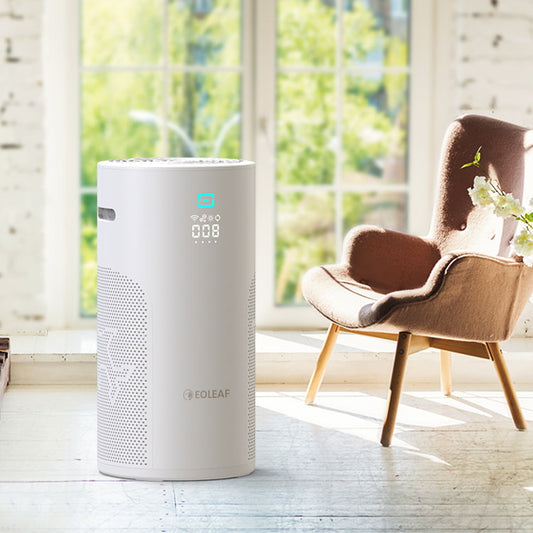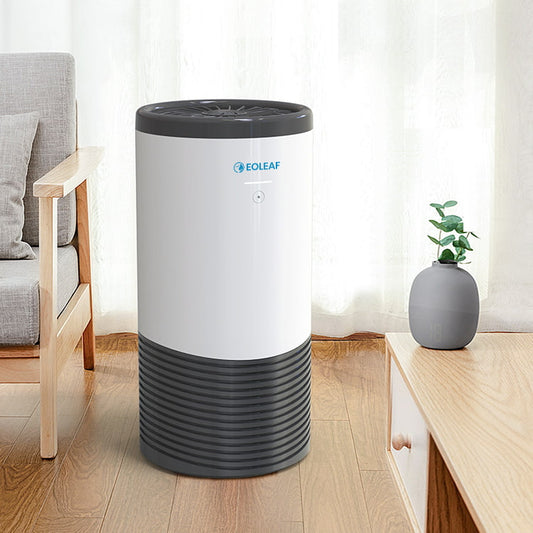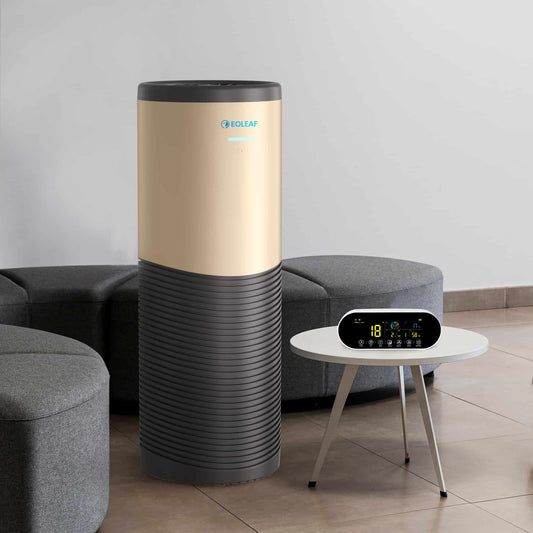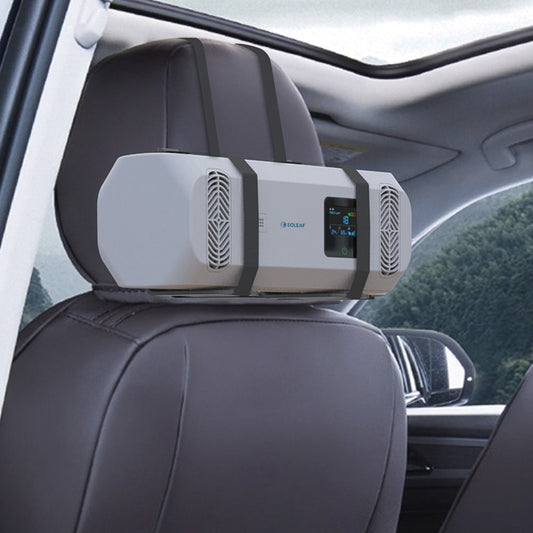The benefits of houseplants on indoor air quality
Humans need greenery for their well-being. Even for the true urbanite, there’s nothing quite like passing through a park on your morning walk to work and seeing the trees sway in the breeze. This is a very effective way to put some pep in your step! Yes, plants are surely aesthetically pleasing, but that’s not all – they can have a significant impact on your well-being. They can reduce our stress levels, boost our moods, make us more productive, and improve concentration. Some studies have even shown that people with illnesses recover more quickly when in the presence of indoor plants1. Additionally, certain plants are capable of decontaminating both water and air. Below we will discuss how plants benefit us by clearing toxins from our air and how we can use them alongside an air purifier to decontaminate the air we breathe at home.

The power of plants
Plants purify the air
Plants bring incredible benefits to both outdoor and indoor settings, notably with their ability to dramatically improve the quality of your indoor air. Several studies have shown that indoor plants have the ability to remove pollutants and reduce bacterial and fungal infection spread from indoor air.
When we breathe, we inhale oxygen and exhale carbon dioxide. During the day, plants do the opposite: they absorb carbon dioxide and release oxygen and water vapour through the process of photosynthesis. When releasing water vapour, a pumping action is initiated. The plant then pulls air that is contaminated with pollutants down to its roots and converts it into food. In fact, the more contaminated air that is allowed to circulate near a plant’s roots, the more it pulls in, and the more effective it is at cleaning indoor air2.
In 1973, when NASA was faced with an indoor air quality crisis inside Skylab space station (after having discovered the presence of 107 volatile organic compounds, or VOCs), finding a solution became top priority. This was an example of a phenomenon which has now been identified as Sick Building Syndrome. Sick Building Syndrome occurs when toxins slowly but continuously released from synthetic materials used in the construction of a building become entrapped in the walls. Since air cannot circulate inside the walls, these toxins seep into the living spaces of the inhabitants, making them fall ill.
This was exactly the effect that was being had on astronauts living in Skylab. Logically, removing all of the synthetic materials inside Skylab wasn’t an option… So, what could be done? The idea became to bring nature indoors. As Bill Wolverton, head of the 1973 study, stated in a 1989 NASA report, “If man is to move into closed environments, on Earth or in space, he must take along nature’s life support system”2.

This study by NASA concluded that plants can remove a whopping 87% of pollutants in the air within a period of 24 hours. Some of these pollutants include:
- VOCs (including benzene and formaldehyde, both known carcinogens)
- Trichloroethylene
- Carbon dioxide build-up
- Carbonyl
- Particulate matter (PM, also known as fine particle pollution)
- Nitrates
- Sulphates
- Ammonia
- Calcium
- Ozone
- Carbonate
This brings to mind the shocking statistic that indoor air is 2 to 5 times more polluted than outdoor air!
Additionally, the following studies have focused on the benefits of houseplants when used as a depolluting method to remove contaminants from indoor air:
- Multiple studies have found that houseplants make an excellent, low-cost solution for passive indoor air pollution improvements3,4,5,6
- Two studies have made findings showing that houseplants are natural air filters and can employ multiple methods of filtration such as absorption, dilution, and precipitation to remove pollutants from the air7,8
- Another study found that, in examining 11 different houseplant species, houseplants are even useful in removing fine and ultrafine particles from indoor air9
Plants regulate humidity levels
It is recommended to maintain an indoor space at a humidity level of between 30 to 60% with an ideal humidity level of around 45%. Indoor air humidity (IAH) can determine your level of comfort in your home or office and can determine germs’ abilities to propagate.
Humidity levels that are too low or too high can lead to various problems in your space. Levels that are too low can cause dried and cracking millwork and/or paint and increased static electricity. Levels that are too high can cause mould and mildew which can lead to more indoor air pollution (airborne spores)10. The latter situation can lead to both more indoor air pollution via airborne spores and a host of negative health effects including allergies.
Plants naturally regulate humidity levels and can decrease air microbiomes. According to another recent study, this capacity also helps reduce the exposure risk to airborne pathogens11.
Plants fight against COVID-19
As mentioned above, by regulating humidity levels in an indoor space, plants help control the propagation of germs (bacteria and viruses). This includes COVID-19.
By moderating indoor humidity levels, plants are able to reduce the viral transmission rate of SARS-CoV-19. The coronavirus is found in aerosols emitted by humans, and high humidity environments provide a perfect breeding ground for the virus, encouraging higher rates of viral transmission. One study found that the effects of reducing humidity and temperature levels by 25 to 30% in summertime may inhibit COVID-19’s propagation12.
However, SARS-CoV-2 and other viruses are also virulent at low relative humidity levels, COVID amore virulent. Unimpeded by aerosols and water droplets present in the air, pathogens can travel further and with more ease. The following graphic compares two different environments: the first (left) shows a plant-free environment that has a low relative humidity level and a high rate of viral transmission. The second (right) shows how a houseplant increases relative humidity levels and reduces the viral transmission rate:

Source 13
By keeping humidity levels from dropping too low or rising too high (under which both conditions viruses are able to thrive), plants provide the much-needed task of keeping pathogen propagation at bay through humidity control.
Harness the combined powers of both an air purifier and plants at home
The simple addition of one or two plants in your space can certainly improve your indoor air. Yet, some argue that in order to truly perfect indoor air quality using plants and plants alone, one must install as many plants as their living space or workplace will allow. However, that many plants could potentially be dangerous as plants release carbon dioxide at night (when photosynthesis stops). That said, an excellent complement would be to equip your space with an air purifier. High-quality air purifiers, like the devices available at Eoleaf, are equipped with HEPA-certified filters which ensures the removal of 99.97% of particles of a size greater than or equal to 0.01 microns. This includes VOCs (up to PM0.1), germs (bacteria, viruses), mould and spores, and allergens (pollen, dust, and dust mites). Your new air purifier, in addition to a couple of plants, can bring you purified, healthy air and protect you from harmful pollutants.
References
1 Lee, S. (2017, July 13). Why indoor plants make you feel better. NBCNews.com. Retrieved October 25, 2022, from https://www.nbcnews.com/better/health/indoor-plants-can-instantly-boost-your-health-happiness-ncna781806
2 NASA. (2007). Plants clean air and water for indoor environments. NASA. Retrieved October 25, 2022, from https://spinoff.nasa.gov/Spinoff2007/ps_3.html
3 Pegas, P. N., Alves, C. A., Nunes, T., Bate-Epey, E. F., Evtyugina, M., & Pio, C. A. (2012). Could houseplants improve indoor air quality in schools? Journal of Toxicology and Environmental Health, Part A, 75(22–23), 1371–1380. https://www.tandfonline.com/doi/abs/10.1080/15287394.2012.721169
4 Soreanu, G., Dixon, M., & Darlington, A. (2013). Botanical biofiltration of indoor gaseous pollutants – a mini-review. Chemical Engineering Journal, 229, 585–594. https://www.sciencedirect.com/science/article/abs/pii/S1385894713008474
5 Abbass, O. A., Sailor, D. J., & Gall, E. T. (2017). Effectiveness of indoor plants for passive removal of indoor ozone. Building and Environment, 119, 62–70. https://www.sciencedirect.com/science/article/pii/S0360132317301592
6 Wei, Z., Van Le, Q., Peng, W., Yang, Y., Yang, H., Gu, H., Lam, S. S., & Sonne, C. (2021). A review on phytoremediation of contaminants in air, water and Soil. Journal of Hazardous Materials, 403, 123658. https://www.sciencedirect.com/science/article/abs/pii/S0304389420316447
7 Kim, K.J., Khalekuzzaman, M., Suh, J.N. et al. Phytoremediation of volatile organic compounds by indoor plants: a review. Hortic. Environ. Biotechnol. 59, 143–157 (2018). https://link.springer.com/article/10.1007/s13580-018-0032-0
8 Lee, B.X.Y., Hadibarata, T. & Yuniarto, A. Phytoremediation Mechanisms in Air Pollution Control: a Review. Water Air Soil Pollut 231, 437 (2020). https://link.springer.com/article/10.1007/s11270-020-04813-6
9 Stapleton E, Ruiz-Rudolph P. The potential for indoor ultrafine particle reduction using vegetation under laboratory conditions. Indoor and Built Environment. 2018;27(1):70-83. doi:10.1177/1420326X16668388
10 Thompson, R. W. (2022, October 26). Ideal indoor humidity levels & how to control them at home. Apartment Therapy. https://www.apartmenttherapy.com/hot-tip-use-a-humidifier-105471
11 Li, H., Wu, Z.-F., Yang, X.-R., An, X.-L., Ren, Y., & Su, J.-Q. (2021). Urban greenness and plant species are key factors in shaping air microbiomes and reducing airborne pathogens. Environment International, 153, 106539. https://www.sciencedirect.com/science/article/pii/S0160412021001641
12 Wang, J., Tang, K., Feng, K., Lin, X., Lv, W., Chen, K., & Wang, F. (2020). High temperature and high humidity reduce the transmission of COVID-19. BMJ Open.
13 El-Tanbouly, R., Hassan, Z., & El-Messeiry, S. (2021). The role of indoor plants in air purification and human health in the context of covid-19 pandemic: A proposal for a novel line of inquiry. Frontiers in Molecular Biosciences, 8. https://www.researchgate.net/publication/352864811_The_Role_of_Indoor_Plants_in_air_Purification_and_Human_Health_in_the_Context_of_COVID-19_Pandemic_A_Proposal_for_a_Novel_Line_of_Inquiry








